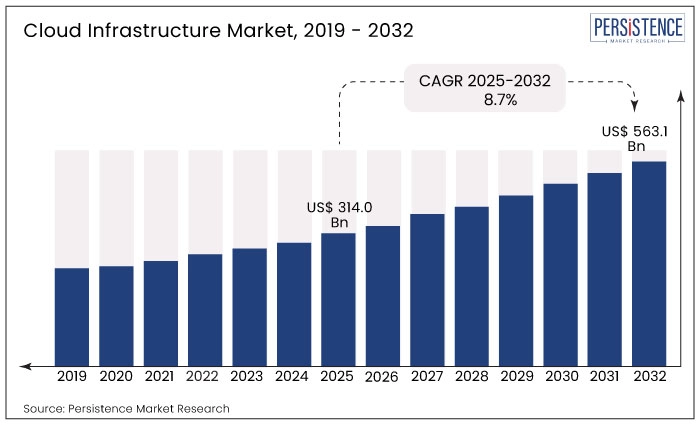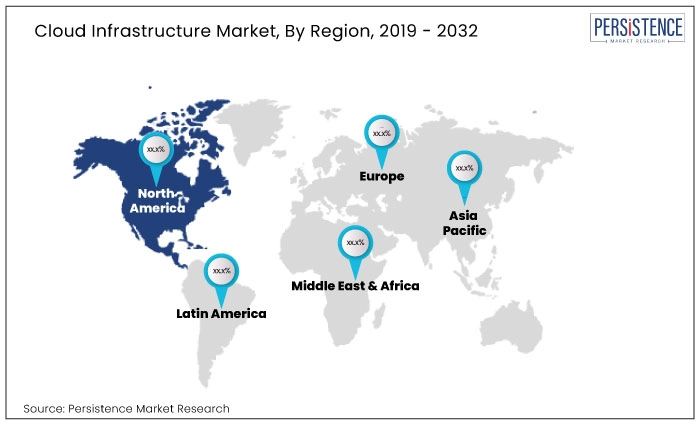ID: PMRREP33462| 198 Pages | 18 Jul 2025 | Format: PDF, Excel, PPT* | IT and Telecommunication

As per a report released by Persistence Market Research (PMR), the global the cloud infrastructure sales in 2025 were held at US$ 314.0 billion. It is likely to expand at 8.7% CAGR from 2025 to 2032. The market is expected to reach a valuation of US$ 563.1 billion by 2032-end.
Based on infrastructure, the private sector is expected to hold significant revenue. It is projected to expand at 8.7% CAGR between 2025 and 2032.
Shift towards cloud adoption across industries has increased as organizations recognize their benefits of scalability, flexibility, and cost saving. This is driven by the need for digital transformation, increased data storage and processing requirements.
Hybrid cloud computing systems are gaining traction as organizations seek to leverage the advantages of both public and private clouds. It allows organizations to balance their requirements for control, security, and agility by integrating on-premises infrastructure. This trend will help in dealing with seamless workload mobility and data portability between environments.
Increasing focus on edge computing and distributed cloud infrastructure is likely to drive demand in the coming decades. Rise in internet of things (IoT) devices and the need for real-time data processing have led to organizations exploring decentralized computing architectures.
Serverless technology is gaining traction, which allows developers to write and run code without managing underlying infrastructure. Edge computing was becoming increasingly important, enabling low-latency processing and real-time decision making.
Containerization and Kubernetes transforming application deployment and management is anticipated to boost demand. Artificial Intelligence (AI) and Machine Learning (ML) workloads, on the other hand, are increasingly popular on cloud management systems.
Growing importance of edge computing and increasing integration of AI and ML in cloud systems will drive growth. This will primarily be due to focus on security and compliance, and the exploration of quantum computing.
Quantum computing is also emerging as a potential game changer, with cloud providers exploring ways to offer access to quantum resources. Another factor that can likely drive growth is rising popularity of edge computing. It helps in enabling low-latency processing and real time decision making.

Key Trends Shaping Market Growth:
Which Factors Are Responsible for Increasing Demand for Cloud Infrastructure Market?
The key factors driving demand for cloud-based services are digital transformation, the emergence of artificial intelligence and remote work. Businesses are shifting more of their IT infrastructure to the cloud as a result of the quickening pace of digital transformation. Businesses are benefited from enhanced flexibility, scalability, and cost savings.
The trend towards remote work has been surging globally. It has fuelled demand for cloud-based collaboration and communication technologies, as well as for cloud infrastructure to serve remote workers.
Big data is expanding, and data-driven decision-making is becoming increasingly important. As a result, there is an increasing need for cloud infrastructure to store, process, and analyse massive volumes of data. IoT device adoption and the huge volume of data they produce have increased the need for cloud infrastructure to store, handle, and analyse this data.
The need for cloud infrastructure to serve AI and ML applications has increased, as requires data processing and storage for machine learning model training.
Businesses are turning more frequently to cloud providers for safe infrastructure and management of their security risks. Its role in prevention of cyberattacks is another key factor fuelling demand in the cloud infrastructure industry.
Which Factors are restraining the Growth of Cloud Infrastructure Market?
The factors restraining the market of cloud infrastructure industry are security concerns, regulatory issues, and network and bandwidth limitations. The security and privacy of an organization's data when it is kept in the cloud is one of the key reasons why companies opt for it.
Organizations might also find it difficult to integrate cloud infrastructure with their current on-premises systems. This is more significant when their IT environments are complicated. Businesses, especially small ones, face challenges due to a lack of internal resources and knowledge to maintain cloud infrastructure.
The use of cloud infrastructure is constrained in businesses due to rigorous rules and standards governing data privacy and security. The adoption of cloud infrastructure in some localities might be constrained by the availability and calibre of network and bandwidth infrastructure in such areas.
| Attributes | Key Insights |
|---|---|
|
Estimated Global Cloud Infrastructure Market Size (2025) |
US$ 314.0 billion |
|
Projected Market Size (2032) |
US$ 563.1 billion |
|
Value-based CAGR (2025 to 2032) |
8.7% |
| Historical Market Growth Rate (CAGR 2019 to 2024) |
7.2% |
As per Persistence Market Research (PMR), in the historical period during 2019 to 2024, the global cloud infrastructure market expanded at 7.2% CAGR. It is likely to enjoy an absolute $ growth opportunity of US$ 292.9 billion through 2032.
During 2025 to 2032, market demand is likely to surpass 8.7% CAGR. The revenue generated from cloud infrastructure industry is poised to reach at US$ 563.1 billion by the end of 2032.
The market is expanding as a result of the growing use of big data, artificial intelligence (AI), and machine learning. These innovations alter the market environment by enabling consumers to track, examine, and display raw data.
Businesses enhance their visualisation skills and make difficult data useable by implementing cutting-edge technology with cloud solutions. The widespread usage of AI and ML technologies has regulated data utilisation and eased data storage challenges.
AI and ML can aid in boosting decision-making processes, lowering operating expenses, and boosting business efficiency. Increasing requirements to store personal and professional data safely will likely push the market.
Research and development efforts are on-going to effectively take advantage of the prospects brought about by IoT. With the use of IoT-based solutions, various players are concentrating on making their goods and services more accessible and convenient.
North America is considered to have the significant cloud infrastructure industry throughout the projection period. It is likely to hold steady at 42% CAGR during the projected period. Amazon Web Services is one of the leading companies in the cloud infrastructure industry in North America market.
Why is the United States poised to Become a Market Hub for Cloud Infrastructure?
The United States cloud infrastructure industry is expected to be worth US$ 149.8 billion by 2032. It is likely to enjoy an absolute dollar growth of US$ 74.5 billion during 2025 to 2032. The cloud infrastructure industry in the United has expanded at a CAGR of 10% from 2019 to 2024, and is expected to accelerate at a CAGR of 7.1% from 2025 to 2032.
The cloud infrastructure industry in the United States is one of the predominant and most developed markets worldwide. The emergence of cloud computing has fundamentally changed how organisations handle, process, and manage their data and applications. Presence of Silicon Valley companies has also greatly helped the cause.
As the need for disaster recovery and business continuity solutions rise, businesses still need to cut their information technology (IT) expenses. These factors are also contributing to the rising acceptance of cloud computing in the United States.
In February 2024, Microsoft Azure, the United States company, launched Azure VMs for US government regions. This will help to improve foundational security. It will also enable credential guard which is backed by secure boot and virtualization-based security.
What Makes China a Lucrative Market for Cloud Infrastructure?
China cloud infrastructure market is expected to hold a valuation of US$ 40.3 billion in 2032. It is likely to enjoy an absolute dollar growth of US$ 23.7 billion. The cloud infrastructure industry in China expanded at 13.1% CAGR from 2019 to 2024. It is expected to surpass a CAGR of 9.3% from 2025 to 2032.
China cloud infrastructure market is largely dominated by domestic players such as Alibaba Cloud, Tencent Cloud, and Huawei Cloud. These companies have invested heavily in building data centers, developing cloud platforms and provides a wide range of services,
In April 2024, to speed up innovation, Alibaba Cloud and VMware jointly released Next-Generation Alibaba Cloud. With the aid of the Alibaba Cloud VMware Service, businesses in China can now move workloads at scale between on-premises VMware infrastructures and Alibaba Cloud more rapidly and more easily.
To improve workload density, speed, availability, and security, the service utilizes the full potential of the VMware Cloud stack. It also operates natively via the modern hardware of Alibaba Cloud. Customers have access to a dependable VMware Cloud platform that facilitates easy workload transfers to Alibaba Cloud VMware Service via vMotion.

Which Type of Cloud Infrastructure is Projected to Witness Significant Growth?
Based on type, services segment of cloud infrastructure industry is projected to witness the skyrocketing growth. It has crucial applications in the telecommunications sector. The sales for this segment grew at around 11.6% from 2019 to 2024. Persistence Market Research (PMR) anticipates the market to expand at around 8.2% CAGR through 2032.
The cloud infrastructure market consists various service segments to carter different needs if the businesses and organization. It includes infrastructure as a service, platforms as a service, relational database as a service, container as a service, and software as a service.
IaaS as a service segment is used to provide virtualized computing resources. It includes virtual machines, storage, and networking over the internet It allows businesses to access and manage their infrastructure components without the need for physical hardware or infrastructure maintenance.
PaaS offering typically includes development tools, runtime environment, and pre-configured application components. It abstracts away the underlying infrastructure, allowing developers to focus on application development and deployment rather than infrastructure management.
Which Segment on the Basis of Infrastructure is expected to be Highly Lucrative?
By infrastructure, private segment is the predominantly applied segment of the cloud infrastructure industry. During 2019 to 2024, sales rose at 11.1% CAGR and are expected to further expand at 8.1% CAGR over the forecast period.
Growing demand for security and compliance in private sectors such as finance, healthcare, and government has been key to market development. It allows organizations to have full control over their data and implement stringent security measures to meet industry-specific requirements.
Private organizations deal with sensitive data such as intellectual property, personally identifiable information, or classified information. By keeping these data within their own infrastructure, organizations have confidence in maintaining data confidentiality while reducing migration risks.
Key players in the cloud infrastructure industry are Alphabet Inc., Amazon Web Services, Inc., Salesforce, Inc., AT&T Inc., International Business Machines Corporation, Alibaba Cloud, Oracle, Tencent Cloud, Cisco Systems. Inc., and NetApp, Inc.
Leading market players are coming up with innovative ways to provide high-quality products. They are also patenting their technologies and products and expand their product lines. Those players, who currently holding small chunks in the market are constantly aiming to increase their market share in the cloud infrastructure industry.
Recent developments:
It is expected to reach US$ 563.1 billion by 2032.
The market is projected to expand at a CAGR of 8.7% during this period.
North America, especially the United States, will lead the market.
Leading companies include Amazon Web Services, IBM, Alibaba Cloud, and Oracle.
Serverless computing, containerization, and Kubernetes are key disruptors.
| Attribute | Details |
|---|---|
|
Historical Data |
2019 to 2024 |
|
Forecast Period |
2025 to 2032 |
|
Quantitative Units |
Value: US$ Bn, Volume: As applicable |
| Report Highlights |
|
|
Segments Covered |
|
|
Regions Covered |
|
|
Key Countries Covered |
|
|
Key Companies Profiled |
|
By Type:
By End User:
By Infrastructure:
By Region:
By Infrastructure:
Delivery Timelines
For more information on this report and its delivery timelines please get in touch with our sales team.
About Author